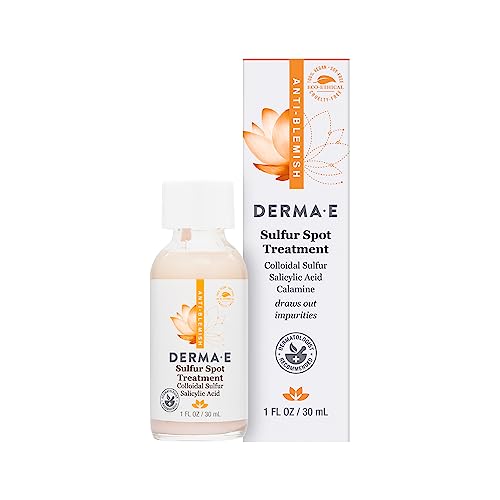
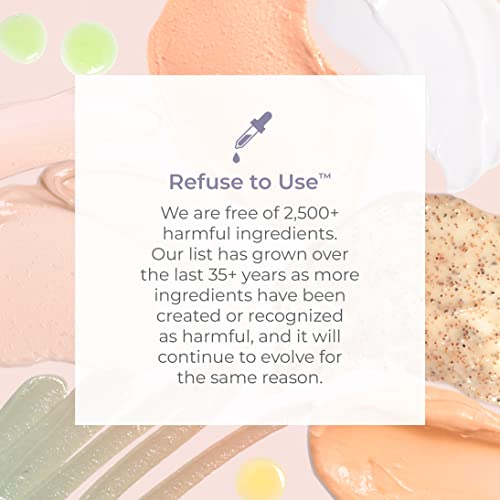
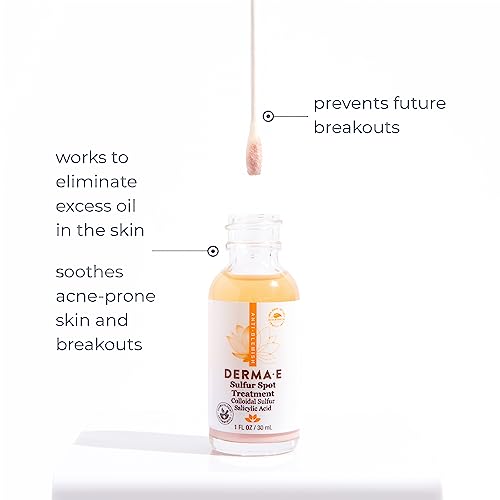
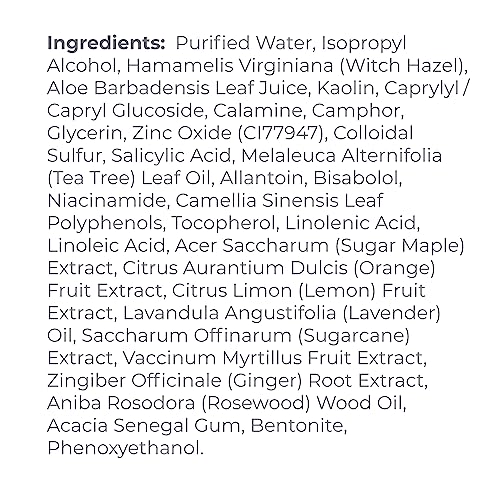
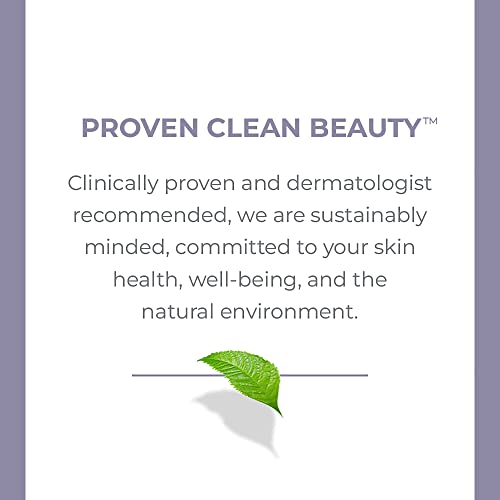
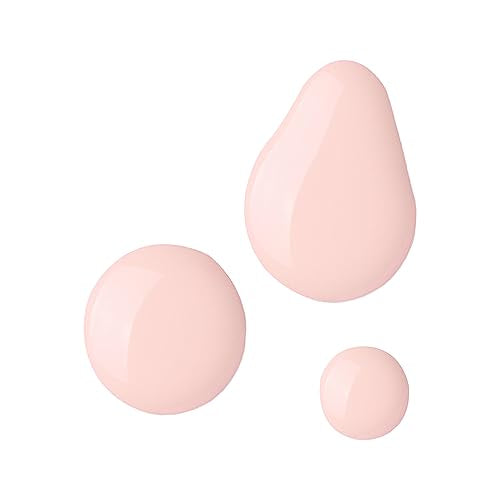
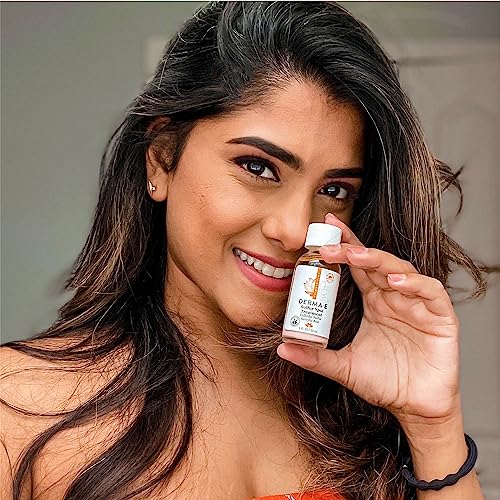
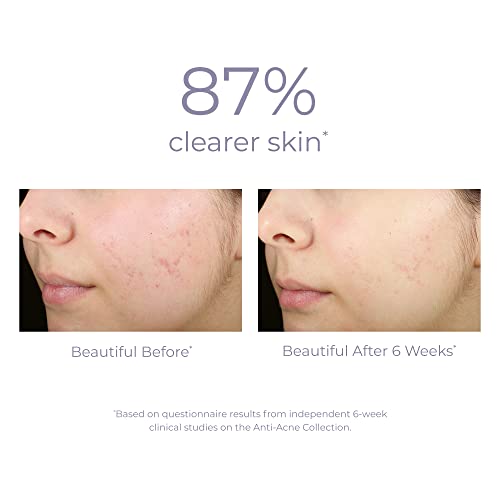
Derma E Blemish & Acne Treatment - Soothing Salicylic Acid & Sulfur Formula - 1 Fl Oz


Salicylic Acid
High RiskSalicylic acid is a naturally occurring and synthetic compound primarily used in skincare products for its ability to exfoliate skin, unclog pores, and treat acne. It is a beta hydroxy acid (BHA) that penetrates the skin to effectively reduce inflammation and promote cell turnover.
Sustai Insights
Salicylic acid is recognized for its effective acne treatment properties and ability to enhance skin absorption, making it beneficial in various formulations. However, its use is subject to restrictions due to potential adverse health effects such as skin irritation and enhanced absorption risks. Regulatory bodies have cautioned against high concentrations, marking it as a high-risk ingredient. Special consideration should be given to sensitive populations, and safer alternatives like glycolic acid may be explored to minimize risks.
Camphor
High RiskCamphor is a waxy, scented substance derived from the wood of the camphor tree (Cinnamomum camphora). It is commonly used in topical applications for its aromatic properties and as a counterirritant. Camphor can also act as a preservative in various formulations.
Sustai Insights
Camphor offers functional benefits as a counterirritant and preservative, effectively providing relief from minor aches and pains. However, it has a high allergenic potential and can cause skin irritation. Regulatory bodies impose moderate restrictions on its use due to these concerns. Environmental risks include its potential as a pollutant, with a high risk assessment based on health impacts and usage restrictions. Safe usage practices are essential, and alternatives like menthol or eucalyptus oil may be safer options.
Zinc Oxide(sunscreen Grade)
Medium RiskZinc oxide (sunscreen grade) is a mineral compound often used in sunscreens for its ability to provide broad-spectrum UV protection. It is micronized to improve its cosmetic feel and skin application, making it suitable for various formulations, including those designed for sensitive skin.
Sustai Insights
Zinc oxide offers effective UV protection and is generally considered safe for topical use; however, it has moderate concerns related to allergies and potential skin absorption. Regulatory bodies have noted use restrictions, particularly in specific formulations. While its environmental impact is relatively low, concerns about enhanced skin absorption warrant caution. Overall, the risk level is assessed as medium, and users are advised to follow safe application practices. Alternatives such as titanium dioxide may provide similar benefits with potentially lower allergenic risks.
Phenoxyethanol
Medium RiskPhenoxyethanol is a preservative used in cosmetics and personal care products to prevent microbial growth and extend shelf life. It is commonly found in formulations such as lotions, creams, and serums.
Sustai Insights
Phenoxyethanol serves effectively as a preservative, ensuring product stability and safety by inhibiting microbial growth. It is considered to have low health risks regarding carcinogenicity, allergies, and reproductive toxicity. However, moderate use restrictions exist, and regulatory bodies have advised caution in specific applications. Environmental concerns include its potential as a pollutant, although it is not highly bioaccumulative. Overall, the ingredient presents a medium risk level, with safe usage practices recommended and alternative preservatives available for those seeking greener options.
Bentonite
Medium RiskBentonite is a native hydrated colloidal aluminum silicate clay that is utilized in various products for its binding, thickening, and absorbent properties. It serves functions such as stabilizing emulsions and enhancing texture in formulations.
Sustai Insights
Bentonite offers functional benefits as a thickening agent and stabilizer, and it is often sourced sustainably. It has low concerns for carcinogenicity, allergies, and developmental toxicity, but moderate use restrictions exist. Environmental risks include potential pollutant characteristics. Regulatory bodies have noted these restrictions, suggesting careful usage. Overall, the risk level is assessed as medium, and users are advised to consider alternatives like kaolin clay for similar properties.
Bisabolol
Medium RiskBisabolol is a scent ingredient naturally occurring in various plants, particularly in chamomile. It is primarily used in cosmetics for its fragrance and potential skin-soothing properties, contributing to the overall sensory experience of personal care products.
Sustai Insights
Bisabolol offers functional benefits as a fragrance component and may provide skin-soothing effects. It is generally recognized for its low carcinogenic risk and low developmental toxicity, though moderate concerns exist regarding allergy potential. Bisabolol is also subject to certain restrictions in verified products. Environmental impacts are minimal, but it should be used with caution in sensitive populations. Overall, it poses a medium risk level based on current scientific understanding.
Linoleic Acid
Low RiskLinoleic acid is a naturally occurring unsaturated fatty acid, primarily found in plant oils such as sunflower, safflower, and corn oil. It plays a crucial role in various biological processes, including cellular membrane structure and function, as well as serving as a precursor for other essential fatty acids.
Sustai Insights
Linoleic acid is recognized for its functional benefits, including supporting skin health and maintaining cellular integrity, while being biodegradable and derived from renewable sources. Health risks are minimal, with low concerns regarding carcinogenicity, allergies, and reproductive toxicity. Environmentally, it poses low risks, with no significant pollutant potential. Regulatory bodies have not imposed major restrictions on linoleic acid, confirming its safety for use. Overall, linoleic acid presents a low risk profile, making it a viable ingredient with sustainable advantages.
Lavandula Angustifolia (Lavender) Flower Oil
Low RiskLavandula angustifolia (lavender) flower oil is an essential oil derived from the flowers of the lavender plant. It is commonly used in personal care products for its aromatic properties and is known for its potential soothing effects in formulations.
Sustai Insights
Lavender oil provides functional benefits such as fragrance enhancement and potential calming effects, contributing to user experience in various personal care products. It is sustainably sourced and has low toxicity levels. Health risks associated with lavender oil are minimal, with low concerns for carcinogenicity, allergies, and reproductive toxicity. Environmental risks are also low, with no significant pollutant concerns. Regulatory assessments indicate no current restrictions, affirming its safety for use. Overall, the ingredient is considered low risk, making it a favorable choice in formulations.
Acer Saccharum (Sugar Maple) Extract
Low RiskAcer saccharum (sugar maple) extract is an extract derived from the sap of the sugar maple tree, traditionally used for its moisturizing and soothing properties in cosmetic formulations. It is often included in skincare products for its potential benefits in improving skin hydration and texture.
Sustai Insights
Acer saccharum extract offers functional benefits as a hydrating agent, contributing to skin moisture retention. It is generally considered low-risk regarding health impacts, with minimal concerns about carcinogenicity, allergies, or reproductive toxicity. Environmentally, it does not pose significant pollutant or bioaccumulation risks. Regulatory bodies have not issued restrictions on its use, affirming its safety profile. Overall, it is assessed as low risk, making it a viable ingredient in cosmetic products. Alternatives are limited, but other plant extracts may also provide similar hydrating benefits.
Melaleuca Alternifolia (Tea Tree)
Low RiskMelaleuca alternifolia, commonly known as tea tree, is an unspecified preparation derived from the leaves of the tea tree. It is primarily used for its antiseptic properties and is found in various personal care products.
Sustai Insights
Tea tree oil offers functional benefits such as antimicrobial properties, making it effective in skincare formulations. It is considered to have low health risks, including low concerns for carcinogenicity, allergies, and reproductive toxicity. Environmental risks are minimal, with no significant pollutant or bioaccumulation potential. Regulatory bodies have noted no major advisories, and overall risk assessment remains low. For safe usage, it is recommended to use appropriate concentrations and consider alternatives like lavender or eucalyptus oil for similar benefits.
Tocopherol, D Alpha
Low RiskTocopherol, specifically d-alpha tocopherol, is a naturally occurring form of Vitamin E. It is commonly used in cosmetic and personal care products primarily for its antioxidant properties, helping to protect formulations from oxidation and extend shelf life.
Sustai Insights
D-alpha tocopherol provides effective antioxidant benefits, contributing to product stability. It is sustainably sourced and generally regarded as safe, with low concerns regarding carcinogenicity, allergies, and reproductive toxicity. However, there are minor concerns about endocrine disruption. Regulatory bodies have not imposed significant restrictions, indicating low overall risk. Recommended usage practices include adhering to established safe concentration thresholds. Alternatives, such as other forms of Vitamin E or plant-based antioxidants, may also be considered.
Citrus Limon (Lemon) Fruit Extract
Low RiskCitrus limon (lemon) fruit extract is derived from the fruit of the lemon tree, Citrus medica limonum. It is commonly used in cosmetic and personal care formulations for its fragrance and potential skin benefits.
Sustai Insights
Citrus limon extract offers functional benefits, including natural fragrance and potential antioxidant properties. It is generally considered safe, with low concerns regarding allergies, carcinogenicity, and reproductive toxicity. However, it may cause skin irritation in sensitive individuals. Environmentally, it poses low risks, as it is biodegradable and not bioaccumulative. Regulatory agencies do not impose significant restrictions on its use. Overall, the risk level for this ingredient is low, making it a favorable choice in formulations.
Linolenic Acid
Low RiskLinolenic acid is an unsaturated fatty acid commonly found in various plant oils. It plays a vital role as an essential fatty acid, which means it must be obtained through diet. This ingredient is used in products for its emollient properties and contribution to skin health.
Sustai Insights
Linolenic acid offers functional benefits, particularly as a moisturizer and skin-conditioning agent, and is derived from sustainable sources. Health risks are minimal, with low concerns regarding carcinogenicity, allergies, and reproductive toxicity. Environmental risks are also low, with no significant pollutant potential. Regulatory bodies have not imposed significant restrictions on its use. Overall, it presents a low risk, making it a favorable choice in formulations, although alternatives such as other plant-based oils may also be considered.
Bois De Rose (Rosewood) Oil
Low RiskBois de rose (rosewood) oil is an essential oil derived from the wood of the Aniba rosaeodora tree. It is primarily utilized for its aromatic properties in perfumes and cosmetics, and may also have applications in aromatherapy due to its soothing scent.
Sustai Insights
Bois de rose oil offers functional benefits as a fragrance component and may possess skin-soothing properties. It is considered sustainably sourced and biodegradable. Health risks associated with the oil are low, with minimal concerns regarding carcinogenicity, allergenic potential, and reproductive toxicity. Environmental risks appear minimal as it does not significantly contribute to pollution or bioaccumulation. Regulatory status indicates no current restrictions. Overall, the ingredient is assessed as low risk, highlighting its safety for use in cosmetic formulations.
Niacinamide
Low RiskNiacinamide, also known as nicotinamide, is a form of vitamin B3 (niacin) that serves various functions in skincare and cosmetic products. It is often used for its potential benefits in improving skin texture, enhancing moisture retention, and supporting the skin's barrier function.
Sustai Insights
Niacinamide provides functional benefits such as enhancing skin hydration and improving the appearance of uneven skin tone. It is generally recognized as safe, with low concerns regarding carcinogenicity, allergies, or reproductive toxicity. However, enhanced skin absorption may pose risks for sensitive individuals. Regulatory bodies impose few restrictions on its use, and it is considered low risk overall. For safer alternatives, options like panthenol may be considered. Overall, niacinamide is a low-risk ingredient when used appropriately.
Water
Low RiskWater is a clear, colorless liquid essential for various biological processes. It serves as a solvent in formulations, facilitating the dissolution of other ingredients and enhancing product texture and application. Additionally, water plays a crucial role in hydration and is a key component in many cosmetic and personal care products.
Sustai Insights
Water is an effective solvent and hydrator, contributing to the texture and efficacy of formulations. It is biodegradable and generally regarded as safe, with low concerns regarding carcinogenicity, allergies, and reproductive toxicity. However, excessive water usage can lead to environmental concerns, particularly regarding resource depletion. Regulatory bodies do not impose restrictions on water use in cosmetics. Overall, the risks associated with water are low, making it a safe and essential ingredient.
Calamine
Low RiskCalamine is a preparation consisting primarily of zinc oxide and a small amount of ferric oxide. It is commonly used in topical formulations for its soothing and protective properties, specifically to relieve itching and irritation caused by minor skin conditions.
Sustai Insights
Calamine offers functional benefits as a skin protectant and anti-itch agent, making it effective for conditions like eczema and insect bites. It is generally regarded as low risk for health concerns, including carcinogenicity and allergies, with no significant environmental hazards noted. Regulatory bodies do not impose restrictions on its use. Safe usage practices include applying it only to affected areas. Alternatives include colloidal oatmeal or aloe vera for similar soothing effects. Overall, the ingredient presents a low risk to health and the environment.
Citrus Aurantium Dulcis (Orange) Fruit Extract
Low RiskCitrus aurantium dulcis (orange) fruit extract is derived from the fruit of the sweet orange tree, primarily utilized for its fragrance and potential antioxidant properties. It is commonly included in cosmetic and personal care products for its sensory attributes and may also have moisturizing effects.
Sustai Insights
Citrus aurantium dulcis (orange) fruit extract offers functional benefits such as fragrance enhancement and potential antioxidant properties. It is generally recognized as safe with low concerns regarding carcinogenicity, allergies, and reproductive toxicity. However, it may pose minimal environmental risks due to its sourcing. Regulatory bodies have not imposed significant restrictions, supporting its low-risk profile. Safe usage practices include avoiding contact with eyes. Alternatives may include other plant extracts for fragrance or antioxidant properties. Overall, this ingredient presents a low risk for health and environmental impacts.
Vegetarian Glycerin
Low RiskVegetarian glycerin, also known as glycerol, is a colorless, odorless, and viscous liquid derived from plant sources. It is primarily used as a humectant, solvent, and emollient in various personal care products, helping to retain moisture and improve texture.
Sustai Insights
Vegetarian glycerin offers functional benefits as an effective humectant, promoting hydration and skin smoothness. It is biodegradable and typically sustainably sourced. Health risks associated with glycerin are low, with no significant concerns for carcinogenicity, allergens, or reproductive toxicity. Environmental risks are minimal, and it is not subject to major regulatory warnings. Overall, the risk level for this ingredient is low, making it a safe choice in formulations. Safe usage practices include ensuring proper concentrations in products, and alternatives such as propylene glycol exist but may have differing properties.
Kaolin
Low RiskKaolin is a clay mineral composed of hydrated aluminum silicate. It is commonly used in various products for its absorbent properties, acting as a thickener, filler, and anti-caking agent in cosmetics, pharmaceuticals, and food applications.
Sustai Insights
Kaolin offers functional benefits such as effective absorption and thickening, making it valuable in personal care and industrial products. It is generally considered safe, with low concerns related to carcinogenicity, allergies, and reproductive toxicity. Environmental risks are minimal, as it is not known to be a pollutant or bioaccumulative. Regulatory bodies impose few restrictions, underscoring its low-risk profile. Safe usage practices are recommended, and while alternatives exist, kaolin remains a low-risk option in its applications.
Isopropyl Alcohol
Low RiskIsopropyl alcohol is a common solvent used in various products for its ability to dissolve oils and resins. It is often utilized in cleaning agents, disinfectants, and personal care products due to its evaporative properties and effectiveness in reducing microbial presence.
Sustai Insights
Isopropyl alcohol serves as an effective solvent and disinfectant, contributing to the cleanliness and efficacy of products. It is considered to have low health risks, with minimal concerns regarding carcinogenicity, allergies, or reproductive toxicity. Environmentally, it is not classified as a significant pollutant or bioaccumulative. Regulatory bodies do not impose severe restrictions on its use, classifying it as low risk overall. Safe usage practices should be followed to mitigate any irritation risks, and while alternatives exist, isopropyl alcohol remains a widely accepted ingredient.
Acacia Senegal Extract
Low RiskAcacia senegal extract is an extract of the flowering tree Acacia senegal, primarily used in cosmetics for its thickening and emulsifying properties. It is commonly found in formulations to enhance texture and stability, serving as a natural alternative to synthetic agents.
Sustai Insights
Acacia senegal extract offers functional benefits as a natural thickener and emulsifier, supporting product stability while being biodegradable and sustainably sourced. Health risks are minimal, with low concerns for carcinogenicity, allergies, and reproductive toxicity. Environmental impact appears low, with no significant pollution or bioaccumulation noted. Regulatory bodies impose no significant restrictions. Overall, the ingredient presents a low-risk profile with safe usage practices, making it a suitable choice in cosmetic formulations.
Allantoin
Low RiskAllantoin is a naturally occurring nitrogenous compound found in various plants and animals. It is commonly used in cosmetic formulations for its soothing and moisturizing properties, as well as its ability to promote skin cell turnover and healing.
Sustai Insights
Allantoin offers functional benefits such as skin soothing, hydration, and promoting cell regeneration. It is generally recognized as safe, with low concerns regarding carcinogenicity, allergies, and reproductive toxicity. Environmentally, it poses minimal risks, being biodegradable and sustainably sourced. Regulatory bodies do not impose significant restrictions on its use. Overall, the risk level associated with allantoin is low, making it a favorable ingredient in personal care products.
Zingiber Officinale (Ginger) Root Extract
Low RiskZingiber officinale (ginger) root extract is derived from the ginger plant, widely recognized for its use in culinary applications and traditional medicine. It serves various functions in products, including flavor enhancement and potential therapeutic benefits due to its bioactive compounds.
Sustai Insights
Ginger root extract offers functional benefits such as flavoring and possible anti-inflammatory properties. It is sustainably sourced and biodegradable. Health risks are low, with minimal concerns regarding carcinogenicity, allergies, or reproductive toxicity. Environmental risks appear low, with no significant pollutants. Regulatory status is favorable, with no major warnings. Overall, the risk level associated with ginger root extract is low, making it a suitable ingredient in various applications.
Hamamelis Virginiana (Witch Hazel) Distillate
Low RiskHamamelis virginiana (witch hazel) distillate is a plant-derived extract commonly used in cosmetic formulations for its astringent and soothing properties. It is primarily utilized for its ability to reduce inflammation and tighten skin, making it a popular ingredient in toners and aftershaves.
Sustai Insights
Witch hazel distillate exhibits several functional benefits, including its anti-inflammatory and astringent properties, which are beneficial for skin care. It is considered to have low health risks regarding carcinogenicity, allergies, and reproductive toxicity, with enhanced skin absorption being noted. Environmental concerns are minimal, as it is not classified as a pollutant or bioaccumulative. Regulatory bodies do not impose significant restrictions on its use. Overall, it is assessed as low risk, with recommendations for safe application in cosmetic products and consideration of alternatives like chamomile extract for similar benefits.
Linoleic Acid
Low RiskLinoleic acid is a naturally occurring unsaturated fatty acid, primarily found in plant oils such as sunflower, safflower, and corn oil. It plays a crucial role in various biological processes, including cellular membrane structure and function, as well as serving as a precursor for other essential fatty acids.
Sustai Insights
Linoleic acid is recognized for its functional benefits, including supporting skin health and maintaining cellular integrity, while being biodegradable and derived from renewable sources. Health risks are minimal, with low concerns regarding carcinogenicity, allergies, and reproductive toxicity. Environmentally, it poses low risks, with no significant pollutant potential. Regulatory bodies have not imposed major restrictions on linoleic acid, confirming its safety for use. Overall, linoleic acid presents a low risk profile, making it a viable ingredient with sustainable advantages.
Zinc Oxide(sunscreen Grade)
Medium RiskZinc oxide (sunscreen grade) is a mineral compound often used in sunscreens for its ability to provide broad-spectrum UV protection. It is micronized to improve its cosmetic feel and skin application, making it suitable for various formulations, including those designed for sensitive skin.
Sustai Insights
Zinc oxide offers effective UV protection and is generally considered safe for topical use; however, it has moderate concerns related to allergies and potential skin absorption. Regulatory bodies have noted use restrictions, particularly in specific formulations. While its environmental impact is relatively low, concerns about enhanced skin absorption warrant caution. Overall, the risk level is assessed as medium, and users are advised to follow safe application practices. Alternatives such as titanium dioxide may provide similar benefits with potentially lower allergenic risks.
Lavandula Angustifolia (Lavender) Flower Oil
Low RiskLavandula angustifolia (lavender) flower oil is an essential oil derived from the flowers of the lavender plant. It is commonly used in personal care products for its aromatic properties and is known for its potential soothing effects in formulations.
Sustai Insights
Lavender oil provides functional benefits such as fragrance enhancement and potential calming effects, contributing to user experience in various personal care products. It is sustainably sourced and has low toxicity levels. Health risks associated with lavender oil are minimal, with low concerns for carcinogenicity, allergies, and reproductive toxicity. Environmental risks are also low, with no significant pollutant concerns. Regulatory assessments indicate no current restrictions, affirming its safety for use. Overall, the ingredient is considered low risk, making it a favorable choice in formulations.
Phenoxyethanol
Medium RiskPhenoxyethanol is a preservative used in cosmetics and personal care products to prevent microbial growth and extend shelf life. It is commonly found in formulations such as lotions, creams, and serums.
Sustai Insights
Phenoxyethanol serves effectively as a preservative, ensuring product stability and safety by inhibiting microbial growth. It is considered to have low health risks regarding carcinogenicity, allergies, and reproductive toxicity. However, moderate use restrictions exist, and regulatory bodies have advised caution in specific applications. Environmental concerns include its potential as a pollutant, although it is not highly bioaccumulative. Overall, the ingredient presents a medium risk level, with safe usage practices recommended and alternative preservatives available for those seeking greener options.
Acer Saccharum (Sugar Maple) Extract
Low RiskAcer saccharum (sugar maple) extract is an extract derived from the sap of the sugar maple tree, traditionally used for its moisturizing and soothing properties in cosmetic formulations. It is often included in skincare products for its potential benefits in improving skin hydration and texture.
Sustai Insights
Acer saccharum extract offers functional benefits as a hydrating agent, contributing to skin moisture retention. It is generally considered low-risk regarding health impacts, with minimal concerns about carcinogenicity, allergies, or reproductive toxicity. Environmentally, it does not pose significant pollutant or bioaccumulation risks. Regulatory bodies have not issued restrictions on its use, affirming its safety profile. Overall, it is assessed as low risk, making it a viable ingredient in cosmetic products. Alternatives are limited, but other plant extracts may also provide similar hydrating benefits.
Melaleuca Alternifolia (Tea Tree)
Low RiskMelaleuca alternifolia, commonly known as tea tree, is an unspecified preparation derived from the leaves of the tea tree. It is primarily used for its antiseptic properties and is found in various personal care products.
Sustai Insights
Tea tree oil offers functional benefits such as antimicrobial properties, making it effective in skincare formulations. It is considered to have low health risks, including low concerns for carcinogenicity, allergies, and reproductive toxicity. Environmental risks are minimal, with no significant pollutant or bioaccumulation potential. Regulatory bodies have noted no major advisories, and overall risk assessment remains low. For safe usage, it is recommended to use appropriate concentrations and consider alternatives like lavender or eucalyptus oil for similar benefits.
Bentonite
Medium RiskBentonite is a native hydrated colloidal aluminum silicate clay that is utilized in various products for its binding, thickening, and absorbent properties. It serves functions such as stabilizing emulsions and enhancing texture in formulations.
Sustai Insights
Bentonite offers functional benefits as a thickening agent and stabilizer, and it is often sourced sustainably. It has low concerns for carcinogenicity, allergies, and developmental toxicity, but moderate use restrictions exist. Environmental risks include potential pollutant characteristics. Regulatory bodies have noted these restrictions, suggesting careful usage. Overall, the risk level is assessed as medium, and users are advised to consider alternatives like kaolin clay for similar properties.
Tocopherol, D Alpha
Low RiskTocopherol, specifically d-alpha tocopherol, is a naturally occurring form of Vitamin E. It is commonly used in cosmetic and personal care products primarily for its antioxidant properties, helping to protect formulations from oxidation and extend shelf life.
Sustai Insights
D-alpha tocopherol provides effective antioxidant benefits, contributing to product stability. It is sustainably sourced and generally regarded as safe, with low concerns regarding carcinogenicity, allergies, and reproductive toxicity. However, there are minor concerns about endocrine disruption. Regulatory bodies have not imposed significant restrictions, indicating low overall risk. Recommended usage practices include adhering to established safe concentration thresholds. Alternatives, such as other forms of Vitamin E or plant-based antioxidants, may also be considered.
Citrus Limon (Lemon) Fruit Extract
Low RiskCitrus limon (lemon) fruit extract is derived from the fruit of the lemon tree, Citrus medica limonum. It is commonly used in cosmetic and personal care formulations for its fragrance and potential skin benefits.
Sustai Insights
Citrus limon extract offers functional benefits, including natural fragrance and potential antioxidant properties. It is generally considered safe, with low concerns regarding allergies, carcinogenicity, and reproductive toxicity. However, it may cause skin irritation in sensitive individuals. Environmentally, it poses low risks, as it is biodegradable and not bioaccumulative. Regulatory agencies do not impose significant restrictions on its use. Overall, the risk level for this ingredient is low, making it a favorable choice in formulations.
Linolenic Acid
Low RiskLinolenic acid is an unsaturated fatty acid commonly found in various plant oils. It plays a vital role as an essential fatty acid, which means it must be obtained through diet. This ingredient is used in products for its emollient properties and contribution to skin health.
Sustai Insights
Linolenic acid offers functional benefits, particularly as a moisturizer and skin-conditioning agent, and is derived from sustainable sources. Health risks are minimal, with low concerns regarding carcinogenicity, allergies, and reproductive toxicity. Environmental risks are also low, with no significant pollutant potential. Regulatory bodies have not imposed significant restrictions on its use. Overall, it presents a low risk, making it a favorable choice in formulations, although alternatives such as other plant-based oils may also be considered.
Bois De Rose (Rosewood) Oil
Low RiskBois de rose (rosewood) oil is an essential oil derived from the wood of the Aniba rosaeodora tree. It is primarily utilized for its aromatic properties in perfumes and cosmetics, and may also have applications in aromatherapy due to its soothing scent.
Sustai Insights
Bois de rose oil offers functional benefits as a fragrance component and may possess skin-soothing properties. It is considered sustainably sourced and biodegradable. Health risks associated with the oil are low, with minimal concerns regarding carcinogenicity, allergenic potential, and reproductive toxicity. Environmental risks appear minimal as it does not significantly contribute to pollution or bioaccumulation. Regulatory status indicates no current restrictions. Overall, the ingredient is assessed as low risk, highlighting its safety for use in cosmetic formulations.
Niacinamide
Low RiskNiacinamide, also known as nicotinamide, is a form of vitamin B3 (niacin) that serves various functions in skincare and cosmetic products. It is often used for its potential benefits in improving skin texture, enhancing moisture retention, and supporting the skin's barrier function.
Sustai Insights
Niacinamide provides functional benefits such as enhancing skin hydration and improving the appearance of uneven skin tone. It is generally recognized as safe, with low concerns regarding carcinogenicity, allergies, or reproductive toxicity. However, enhanced skin absorption may pose risks for sensitive individuals. Regulatory bodies impose few restrictions on its use, and it is considered low risk overall. For safer alternatives, options like panthenol may be considered. Overall, niacinamide is a low-risk ingredient when used appropriately.
Water
Low RiskWater is a clear, colorless liquid essential for various biological processes. It serves as a solvent in formulations, facilitating the dissolution of other ingredients and enhancing product texture and application. Additionally, water plays a crucial role in hydration and is a key component in many cosmetic and personal care products.
Sustai Insights
Water is an effective solvent and hydrator, contributing to the texture and efficacy of formulations. It is biodegradable and generally regarded as safe, with low concerns regarding carcinogenicity, allergies, and reproductive toxicity. However, excessive water usage can lead to environmental concerns, particularly regarding resource depletion. Regulatory bodies do not impose restrictions on water use in cosmetics. Overall, the risks associated with water are low, making it a safe and essential ingredient.
Bisabolol
Medium RiskBisabolol is a scent ingredient naturally occurring in various plants, particularly in chamomile. It is primarily used in cosmetics for its fragrance and potential skin-soothing properties, contributing to the overall sensory experience of personal care products.
Sustai Insights
Bisabolol offers functional benefits as a fragrance component and may provide skin-soothing effects. It is generally recognized for its low carcinogenic risk and low developmental toxicity, though moderate concerns exist regarding allergy potential. Bisabolol is also subject to certain restrictions in verified products. Environmental impacts are minimal, but it should be used with caution in sensitive populations. Overall, it poses a medium risk level based on current scientific understanding.
Calamine
Low RiskCalamine is a preparation consisting primarily of zinc oxide and a small amount of ferric oxide. It is commonly used in topical formulations for its soothing and protective properties, specifically to relieve itching and irritation caused by minor skin conditions.
Sustai Insights
Calamine offers functional benefits as a skin protectant and anti-itch agent, making it effective for conditions like eczema and insect bites. It is generally regarded as low risk for health concerns, including carcinogenicity and allergies, with no significant environmental hazards noted. Regulatory bodies do not impose restrictions on its use. Safe usage practices include applying it only to affected areas. Alternatives include colloidal oatmeal or aloe vera for similar soothing effects. Overall, the ingredient presents a low risk to health and the environment.
Citrus Aurantium Dulcis (Orange) Fruit Extract
Low RiskCitrus aurantium dulcis (orange) fruit extract is derived from the fruit of the sweet orange tree, primarily utilized for its fragrance and potential antioxidant properties. It is commonly included in cosmetic and personal care products for its sensory attributes and may also have moisturizing effects.
Sustai Insights
Citrus aurantium dulcis (orange) fruit extract offers functional benefits such as fragrance enhancement and potential antioxidant properties. It is generally recognized as safe with low concerns regarding carcinogenicity, allergies, and reproductive toxicity. However, it may pose minimal environmental risks due to its sourcing. Regulatory bodies have not imposed significant restrictions, supporting its low-risk profile. Safe usage practices include avoiding contact with eyes. Alternatives may include other plant extracts for fragrance or antioxidant properties. Overall, this ingredient presents a low risk for health and environmental impacts.
Salicylic Acid
High RiskSalicylic acid is a naturally occurring and synthetic compound primarily used in skincare products for its ability to exfoliate skin, unclog pores, and treat acne. It is a beta hydroxy acid (BHA) that penetrates the skin to effectively reduce inflammation and promote cell turnover.
Sustai Insights
Salicylic acid is recognized for its effective acne treatment properties and ability to enhance skin absorption, making it beneficial in various formulations. However, its use is subject to restrictions due to potential adverse health effects such as skin irritation and enhanced absorption risks. Regulatory bodies have cautioned against high concentrations, marking it as a high-risk ingredient. Special consideration should be given to sensitive populations, and safer alternatives like glycolic acid may be explored to minimize risks.
Vegetarian Glycerin
Low RiskVegetarian glycerin, also known as glycerol, is a colorless, odorless, and viscous liquid derived from plant sources. It is primarily used as a humectant, solvent, and emollient in various personal care products, helping to retain moisture and improve texture.
Sustai Insights
Vegetarian glycerin offers functional benefits as an effective humectant, promoting hydration and skin smoothness. It is biodegradable and typically sustainably sourced. Health risks associated with glycerin are low, with no significant concerns for carcinogenicity, allergens, or reproductive toxicity. Environmental risks are minimal, and it is not subject to major regulatory warnings. Overall, the risk level for this ingredient is low, making it a safe choice in formulations. Safe usage practices include ensuring proper concentrations in products, and alternatives such as propylene glycol exist but may have differing properties.
Camphor
High RiskCamphor is a waxy, scented substance derived from the wood of the camphor tree (Cinnamomum camphora). It is commonly used in topical applications for its aromatic properties and as a counterirritant. Camphor can also act as a preservative in various formulations.
Sustai Insights
Camphor offers functional benefits as a counterirritant and preservative, effectively providing relief from minor aches and pains. However, it has a high allergenic potential and can cause skin irritation. Regulatory bodies impose moderate restrictions on its use due to these concerns. Environmental risks include its potential as a pollutant, with a high risk assessment based on health impacts and usage restrictions. Safe usage practices are essential, and alternatives like menthol or eucalyptus oil may be safer options.
Kaolin
Low RiskKaolin is a clay mineral composed of hydrated aluminum silicate. It is commonly used in various products for its absorbent properties, acting as a thickener, filler, and anti-caking agent in cosmetics, pharmaceuticals, and food applications.
Sustai Insights
Kaolin offers functional benefits such as effective absorption and thickening, making it valuable in personal care and industrial products. It is generally considered safe, with low concerns related to carcinogenicity, allergies, and reproductive toxicity. Environmental risks are minimal, as it is not known to be a pollutant or bioaccumulative. Regulatory bodies impose few restrictions, underscoring its low-risk profile. Safe usage practices are recommended, and while alternatives exist, kaolin remains a low-risk option in its applications.
Isopropyl Alcohol
Low RiskIsopropyl alcohol is a common solvent used in various products for its ability to dissolve oils and resins. It is often utilized in cleaning agents, disinfectants, and personal care products due to its evaporative properties and effectiveness in reducing microbial presence.
Sustai Insights
Isopropyl alcohol serves as an effective solvent and disinfectant, contributing to the cleanliness and efficacy of products. It is considered to have low health risks, with minimal concerns regarding carcinogenicity, allergies, or reproductive toxicity. Environmentally, it is not classified as a significant pollutant or bioaccumulative. Regulatory bodies do not impose severe restrictions on its use, classifying it as low risk overall. Safe usage practices should be followed to mitigate any irritation risks, and while alternatives exist, isopropyl alcohol remains a widely accepted ingredient.
Acacia Senegal Extract
Low RiskAcacia senegal extract is an extract of the flowering tree Acacia senegal, primarily used in cosmetics for its thickening and emulsifying properties. It is commonly found in formulations to enhance texture and stability, serving as a natural alternative to synthetic agents.
Sustai Insights
Acacia senegal extract offers functional benefits as a natural thickener and emulsifier, supporting product stability while being biodegradable and sustainably sourced. Health risks are minimal, with low concerns for carcinogenicity, allergies, and reproductive toxicity. Environmental impact appears low, with no significant pollution or bioaccumulation noted. Regulatory bodies impose no significant restrictions. Overall, the ingredient presents a low-risk profile with safe usage practices, making it a suitable choice in cosmetic formulations.
Allantoin
Low RiskAllantoin is a naturally occurring nitrogenous compound found in various plants and animals. It is commonly used in cosmetic formulations for its soothing and moisturizing properties, as well as its ability to promote skin cell turnover and healing.
Sustai Insights
Allantoin offers functional benefits such as skin soothing, hydration, and promoting cell regeneration. It is generally recognized as safe, with low concerns regarding carcinogenicity, allergies, and reproductive toxicity. Environmentally, it poses minimal risks, being biodegradable and sustainably sourced. Regulatory bodies do not impose significant restrictions on its use. Overall, the risk level associated with allantoin is low, making it a favorable ingredient in personal care products.
Zingiber Officinale (Ginger) Root Extract
Low RiskZingiber officinale (ginger) root extract is derived from the ginger plant, widely recognized for its use in culinary applications and traditional medicine. It serves various functions in products, including flavor enhancement and potential therapeutic benefits due to its bioactive compounds.
Sustai Insights
Ginger root extract offers functional benefits such as flavoring and possible anti-inflammatory properties. It is sustainably sourced and biodegradable. Health risks are low, with minimal concerns regarding carcinogenicity, allergies, or reproductive toxicity. Environmental risks appear low, with no significant pollutants. Regulatory status is favorable, with no major warnings. Overall, the risk level associated with ginger root extract is low, making it a suitable ingredient in various applications.
Hamamelis Virginiana (Witch Hazel) Distillate
Low RiskHamamelis virginiana (witch hazel) distillate is a plant-derived extract commonly used in cosmetic formulations for its astringent and soothing properties. It is primarily utilized for its ability to reduce inflammation and tighten skin, making it a popular ingredient in toners and aftershaves.
Sustai Insights
Witch hazel distillate exhibits several functional benefits, including its anti-inflammatory and astringent properties, which are beneficial for skin care. It is considered to have low health risks regarding carcinogenicity, allergies, and reproductive toxicity, with enhanced skin absorption being noted. Environmental concerns are minimal, as it is not classified as a pollutant or bioaccumulative. Regulatory bodies do not impose significant restrictions on its use. Overall, it is assessed as low risk, with recommendations for safe application in cosmetic products and consideration of alternatives like chamomile extract for similar benefits.
Experience clear, blemish-free skin with Derma E Sulfur Spot Treatment, a powerful solution designed for breakout-prone skin. This soothing lotion effectively targets blemishes while being kind to the environment.
- Fast-Acting Treatment: Calamine and colloidal sulfur work together to quickly dry out excess oil and reduce irritation, providing immediate relief for troubled skin.
- Prevents Future Breakouts: Enriched with salicylic acid, this treatment helps eliminate dead skin cells and impurities, preventing new blemishes from forming.
- Natural Ingredients: Infused with witch hazel, niacinamide, and aloe vera, it calms irritation and softens the skin, ensuring a gentle touch.
- Easy Application: For optimal results, simply dip a cotton swab into the pink sediment and apply directly to affected areas, making it perfect for overnight use.
- Eco-Friendly Commitment: 100% vegan and cruelty-free, Derma E’s clean beauty ethos ensures no harmful chemicals like parabens or sulfates are included, supporting your health and the planet.
Subscribe & Save with Sustai
- Best Price Guarantee: Always enjoy the lowest prices on sustainable home essentials.
- No Surprises: We’ll notify you before shipping. No hidden fees, ever.
- You’re in Charge: Change, pause, or cancel your subscription anytime with ease.
- Eco-Friendly Deliveries: Our grouped shipments mean less packaging and lower emissions.
Join us on a sustainable journey. Special offers for a limited time! Prices and promotions may change.
Recommended Products
Experience clear, blemish-free skin with Derma E Sulfur Spot Treatment, a powerful solution designed for breakout-prone skin. This soothing lotion effectively targets blemishes while being kind to the environment.
- Fast-Acting Treatment: Calamine and colloidal sulfur work together to quickly dry out excess oil and reduce irritation, providing immediate relief for troubled skin.
- Prevents Future Breakouts: Enriched with salicylic acid, this treatment helps eliminate dead skin cells and impurities, preventing new blemishes from forming.
- Natural Ingredients: Infused with witch hazel, niacinamide, and aloe vera, it calms irritation and softens the skin, ensuring a gentle touch.
- Easy Application: For optimal results, simply dip a cotton swab into the pink sediment and apply directly to affected areas, making it perfect for overnight use.
- Eco-Friendly Commitment: 100% vegan and cruelty-free, Derma E’s clean beauty ethos ensures no harmful chemicals like parabens or sulfates are included, supporting your health and the planet.

You can have at most 2 Sustainable Steals products in your cart
Customer Reviews
Customers’ View
Customers generally find the Spot Treatment effective for managing blemishes, with many noting its fast-acting formula that provides noticeable results overnight. Positive feedback often highlights the product's natural ingredients, including Witch Hazel and Aloe Vera, which are appreciated for their soothing properties. Users also mention the ease of application, as the treatment can be directly targeted to specific areas. Notably, environmentally conscious consumers value that the product is 100% vegan and cruelty-free, aligning with their health and sustainability values. However, some users expressed concerns about the product's consistency and perceived value compared to similar items available at lower prices. Overall, many customers feel the product is a reliable addition to their skincare regimens, providing both efficacy and peace of mind regarding its ingredient integrity.
AI-generated from the text of customer reviewsThis product has no reviews yet.




